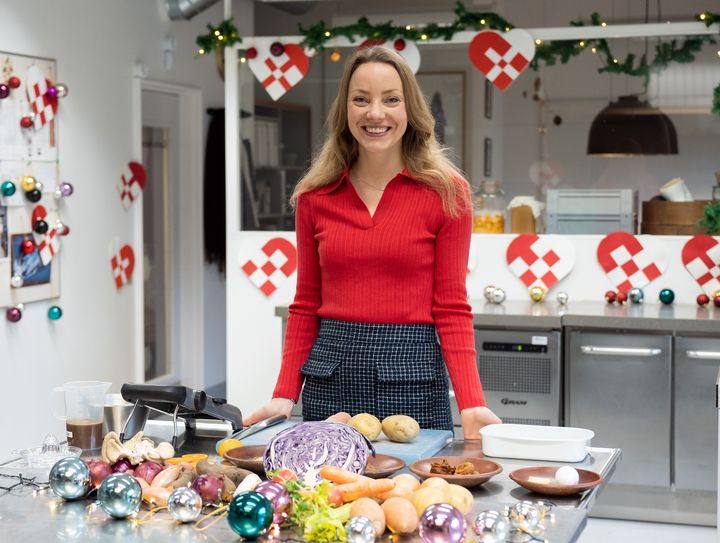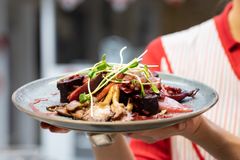Researcher: Umami is key to make plant-based Christmas dinner taste like Christmas

Meat will be the focal point of most families’ Christmas feasts this year. In Danish homes, duck, goose or roast pork typically share the plate with caramelized potatoes, red cabbage, pickled veg and brown sauce.
But what if you want to swap the duck or pork out with something plant-based this year? Or, perhaps there will be a vegetarian guest or two at the Christmas table? There can be many reasons to find alternatives to the Christmas classics. Can you do so without abandoning the flavours of Christmas?
Food scientist and ph.d. Charlotte Vinther Schmidt, postdoc at the University of Copenhagen at Department of Food Science serves up a suggestion. Her research focuses on exploiting the umami taste potential of sustainable foods.
Several things are crucial in developing the "flavours of Christmas” in plant-based fare. One of the most important, according to Charlotte Vinther Schmidt, is for dishes to have enough of the fifth basic taste – umami.
Umami and the creation of Christmas flavour
"Meat is known for its powerful umami taste. If you plan on doing away with meat in your Christmas dinner, you can boost the umami taste of the plant-based ingredients by umami synergy, and in doing so, bring umami taste to food items that don’t normally taste of umami," says Charlotte Vinther Schmidt, who does just that in her alternative Christmas menu suggestion.
Scientifically, the taste of umami occurs when the free amino acid glutamate is present in food. Charlotte Vinther Schmidt explains that the umami synergy principle makes it possible to enhance the umami taste of glutamate significantly, important for the overall deliciousness when you look out to decrease or leave out meat entirely:
"You can achieve the umami synergy effect by combining foods with glutamate with foods that have a high content of specific other substances called nucleotides. While nucleotides don’t give off umami taste per se, they boost the umami taste greatly when combined with glutamate in the same mouthful. A general rule of thumb is that 1-part glutamate + 1-part nucleotides gives an umami taste intensity equivalent to 8 parts glutamate."
We are familiar with this effect from famed 'pairings' like champagne and oysters, ham and cheese, and bacon and eggs.
Furthermore, Charlotte Vinther Schmidt suggests that – to keep the flavours Christmassy – one can make use of traditional yuletide ingredients that aren’t animal based, like red cabbage, cranberries and spices such as cloves, cinnamon and allspice.
"Overall, one should think about what makes a classic Christmas dinner taste so good; for example, what basic taste are present, what textures, what aromas? By dividing the meal into subcomponents like this, you can recreate it in another meal using completely different ingredients. Doing so will deliver the same food properties and stimulate the same senses and secure the overall deliciousness and satisfaction of the meal," says the researcher.
Charlotte's Christmas menu
Charlotte Vinther Schmidt has put together a plant-based Christmas dinner based on the principles above. The meal includes:
- Sweet and umami tasting miso potatos – Baked layered yellow and sweet potatoes in light miso, yeast flakes, cloves and allspice.
- Fried oyster mushrooms with caramelized onions and beets in red wine
- Fresh Christmas salad of finely sliced cabbage, endive, chopped apples and fresh sunflower shoots served with a dressing with clementine juice, light miso and walnut oil, topped with roasted walnuts and cranberries.
"The first component on the plate is a reimagined, ‘umamified’ version of caramelized potatoes. The umami synergy occurs when the glutamate-rich miso interacts with the touch of glutamate in potatoes and yeast flakes, the latter which contain both glutamate and nucleotides. The spices help to evoke classic Christmas aromas," says Charlotte Vinther Schmidt.
The second component of the dish is whole shallots and sliced beets simmered in the extract from vegetables and red wine.
"The unique thing about the onions is that when cooking their extract contains a number of so-called kokumi peptides, which give mouthfeel and continuity which is enhanced by umami taste from the fried oyster mushrooms which contain both glutamate and nucleotides and are very umami in taste. together with the onions which caramelize and become sweeter – they giving rise to our two basic taste cravings, sweetness and umami," says the researcher.
The frying of the mushrooms, such as oyster mushrooms, at high dry heat will develop socalled Maillard aromas which can further improve perceived umami taste. These aromatic substances are triggered in a chemical reaction between free amino acids and sugars when food is browned, an aroma that we know from freshly baked bread or seared meat.
The final component is a fresh red cabbage, endive and apple salad dressed with clementine juice and a light miso paste, that contributes both Christmas ingredients and freshness to the dish.
The entire dinner takes between 60-90 minutes to prepare. See the recipe here.
Shopping tips
Charlotte Vinther Schmidt composed the dish based on the criterion of seasonal ingredients being used.
“If you are focused on eating as sustainably as possible, the rule of thumb is to eat what’s in season in whichever country you find yourself. But It’s not just about local products. Because, even though you can buy Danish tomatoes in winter, they are grown in energy intensive greenhouses that need to be heated,” Charlotte Vinther Schmidt points out.
The most 'exotic' element of Christmas dishes is the soya bean paste miso, originally from Japan. Miso can be found in many large supermarkets and Asian grocers, but Charlotte Vinther Schmidt emphasizes that Danish producers have also come on the market that miso is produced using local ingredients.
FACT BOX:
Find Charlotte Vinther Schmidt's Green Christmas Recipes here.
Charlotte Vinther Schmidt is a food engineer and PhD in food science who focuses on umami and sustainable protein sources. She works as a scientific researcher at the University of Copenhagen’s Department of Food Science and communicates the science behind umami and palatability, among other things on umamipairing.com and @umamipairing on Instagram.
FACT BOX – UMAMI, KOKUMI and MAILLARD
- Umami is one of the five basic tastes, alongside sweet, sour, salty, bitter. Umami taste comes from the free amino acid glutamate and certain free nucleotides. Foods like cheese, mushrooms, meat and sun-ripened tomatoes are high in umami.
- In Japanese, kokumi means "palatability" or "rich taste". Kokumi is the term for small pieces of protein called di- and tri-peptides, which are found in onions, fish sauce and soy sauce. Kokumi can increase umami taste and vice versa, providing mouthfeel and a long-lasting taste effect.
- Maillard is the term given to a series of chemical reactions between amino acids and sugars that develop aromas and flavors when food is browned. The frying of meat and baking of bread are examples of where kokumi occurs. French chemist and physician Louis-Camille Maillard first described the reactions in 1912.
Keywords
Contacts
Charlotte Vinther SchmidtDepartment of Food Science - University of Copenhagen
charlotte.vinter@food.ku.dkMaria HornbekJournalistFaculty of Science - University of Copenhagen
Tel:+4522954283maho@science.ku.dkImages
Documents
Links
About Københavns Universitet - Det Natur- og Biovidenskabelige Fakultet
 Københavns Universitet - Det Natur- og Biovidenskabelige Fakultet
Københavns Universitet - Det Natur- og Biovidenskabelige FakultetBülowsvej 17
1870 Frederiksberg C
35 33 28 28https://science.ku.dk/
Det Natur- og Biovidenskabelige Fakultet på Københavns Universitet – SCIENCE – er landets største naturvidenskabelige forsknings- og uddannelsesinstitution.
Fakultetets væsentligste opgave er at bidrage til løsning af de store udfordringer, som vi står overfor i en verden under hastig forandring med øget pres på bl.a. naturressourcer og markante klimaforandringer - både nationalt og globalt.
Subscribe to releases from Københavns Universitet - Det Natur- og Biovidenskabelige Fakultet
Subscribe to all the latest releases from Københavns Universitet - Det Natur- og Biovidenskabelige Fakultet by registering your e-mail address below. You can unsubscribe at any time.
Latest releases from Københavns Universitet - Det Natur- og Biovidenskabelige Fakultet
Nyt studie peger på Skagerrak som et slags ”fritidshjem” for den gådefulde grønlandshaj9.7.2025 09:00:00 CEST | Pressemeddelelse
Grønlandshajen – verdens længstlevende hvirveldyr – forbindes oftest med kolde arktiske vande. Et nyt internationalt studie ledt af forskere fra Grønlands Naturinstitut og Københavns Universitet viser dog, at Skagerrak sandsynligvis fungerer som opvækstområde for unge grønlandshajer. Studiet peger også på at grønlandshajer slet ikke fødes i hverken Grønland eller andre steder i Arktis.
Old aerial photos give scientists a new tool to predict sea level rise3.7.2025 08:00:00 CEST | Press release
Researchers from the University of Copenhagen have gained unique insight into the mechanisms behind the collapse of Antarctic ice shelves, which are crucial for sea level rise in the Northern Hemisphere. The discovery of old aerial photos has provided an unparalleled dataset that can improve predictions of sea level rise and how we should prioritise coastal protection and other forms of climate adaptation.
Gamle luftfotos giver forskere nyt redskab til at forudsige havstigninger3.7.2025 08:00:00 CEST | Pressemeddelelse
Forskere fra Københavns Universitet har fået unik adgang til at forstå mekanismerne bag antarktiske ishylders kollaps, som er afgørende for havstigninger på den nordlige halvkugle. Et fund af gamle luftfotos har skabt et enestående datasæt, som kan forbedre vores forudsigelser af hvor meget havene stiger, og vores prioritering af kystsikring og andre klimatilpasninger.
Ny institutleder på IFRO: ”Faglighed og fællesskab går hånd i hånd”1.7.2025 10:49:17 CEST | Pressemeddelelse
Per Svejstrup er fra 1. august ansat som institutleder på Institut for Fødevare- og Ressourceøkonomi (IFRO). Den kommende leder træder ind i rollen med stor respekt for IFRO's faglige og kollegiale kultur med klare ambitioner for fremtiden.
Dangerous Variant of Salmonella Still Not Eradicated – Researchers Point to the Solutions1.7.2025 09:53:23 CEST | Press release
The infectious and multi-resistant cattle disease Salmonella Dublin can be fatal to both humans and animals and causes significant losses for farmers. Although Denmark has attempted to eradicate the disease since 2008, it has not yet succeeded. A study from the University of Copenhagen points to possible reasons – and the necessary solutions.
In our pressroom you can read all our latest releases, find our press contacts, images, documents and other relevant information about us.
Visit our pressroom

